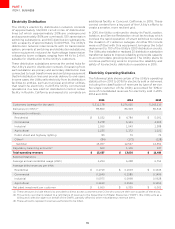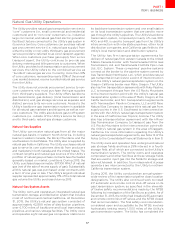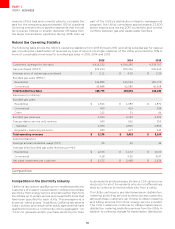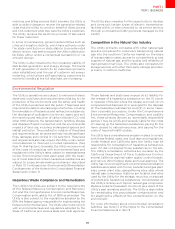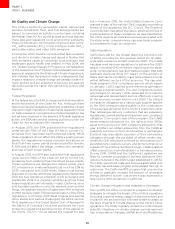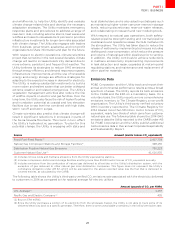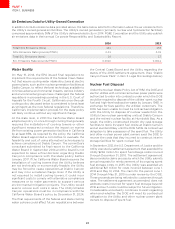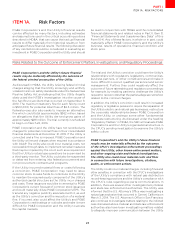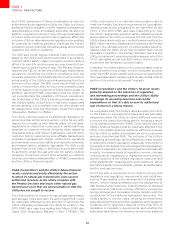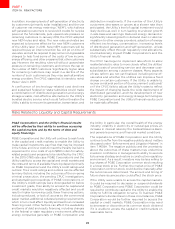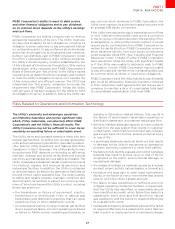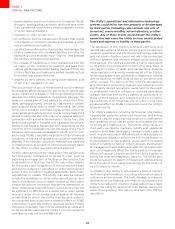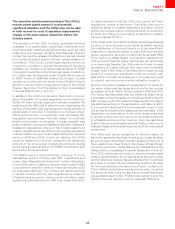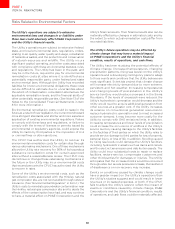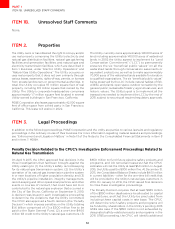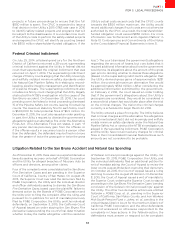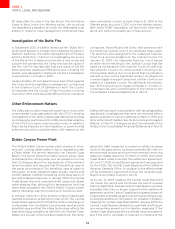PG&E 2015 Annual Report Download - page 32
Download and view the complete annual report
Please find page 32 of the 2015 PG&E annual report below. You can navigate through the pages in the report by either clicking on the pages listed below, or by using the keyword search tool below to find specific information within the annual report.
24
PART I
ITEM 1A.RISK FACTORS
and CPUC personnel. If these investigations result in
enforcement action against the Utility, the Utility could incur
additional fines or penalties or suer negative consequences
described above in the immediately preceding risk factor. In
addition, a negative outcome in any of these investigations
or future enforcement actions may negatively aect the
outcome of future ratemaking and regulatory proceedings;
for example, by enabling parties to challenge the Utility’s
request to recover costs that the parties allege are somehow
related to the Utility’s violations.
The SED also could impose material fines on the Utility
based on the Utility’s self-reports submitted in accordance
with the SED’s safety citation program and the Utility’s
eorts to identify and remove encroachments from
transmission pipeline rights of way. The Penalty Decision
requires the SED to review the Utility’s gas transmission
operations (including the Utility’s compliance with the
remedies ordered by the Penalty Decision) and to perform
annual audits of the Utility’s record-keeping practices for a
minimum of ten years. The SED could impose fines on the
Utility or require the Utility to incur unrecoverable costs,
or both, based on the outcome of these future audits. In
addition, although PG&E Corporation and the Utility do
not currently face the possibility of fines or penalties in
the first phase of the CPUC’s pending investigation into
the Utility’s safety culture since it has been categorized
as rate setting, it is uncertain how the next phase will
be categorized. (See the discussion under the heading
“Regulatory Matters” in MD&A.)
The Utility could be subject to additional regulatory or
governmental enforcement action in the future with
respect to compliance with federal, state or local laws,
regulations or orders that could result in additional fines,
penalties or customer refunds, including those regarding
renewable energy and resource adequacy requirements;
customer billing; customer service; aliate transactions;
vegetation management; design, construction, operating
and maintenance practices; safety and inspection practices;
and federal electric reliability standards. The SED could
impose fines on the Utility in the future in accordance with
its authority under the gas and electric safety citation
programs. The amount of such fines, penalties, or customer
refunds could have a material eect on PG&E Corporation’s
and the Utility’s financial results.
PG&E Corporation’s and the Utility’s future financial
results could be materially aected by the extent
to which its natural gas transmission costs exceed
authorized revenues as the Utility complies with
the Penalty Decision and incurs other natural gas
transmission costs that are unrecoverable or that the
Utility has not sought to recover.
The Utility’s ability to recover its natural gas transmission
and storage costs and earn its authorized ROE could
be materially aected by the amount of revenues the
CPUC ultimately authorizes the Utility to collect in the
2015 GT&S rate case proceeding and future GT&S rate
cases. (See“Regulatory Matters” in Item 7. MD&A.) The
Utility continues to incur material unrecoverable costs to
meet the Penalty Decision’s requirement to fund safety-
related projects and programs to be identified by the
CPUC in the 2015 GT&S rate case. Depending on how
the CPUC designates pipeline safety-related projects
and programs the Utility is required to fund, and how the
Utility’s associated costs are counted toward meeting the
$850 million maximum disallowance imposed by thePenalty
Decision, the ultimate amount of unrecoverable pipeline-
related costs the Utility incurs may be higher than current
forecasts. In addition, the Penalty Decision requires the
Utility to implement various remedial measures which the
CPUC estimated would cost $50 million. Actual costs to
implement the remedies could be higher.
In addition, the Utility plans to incur unrecoverable coststo
continue performing certain work to complete projects
under the PSEP and to identify and remove encroachments
from gas transmission pipeline rights-of-way. Actual coststo
perform this work could exceed forecasts.
PG&E Corporation’s and the Utility’s financial results
primarily depend on the outcomes of regulatory
and ratemaking proceedings and the Utility’s ability
to manage its operating expenses and capital
expenditures so that it is able to earn its authorized
rate of return in a timely manner.
As a regulated entity, the Utility’s rates are set by the CPUC
or the FERC on a prospective basis and are generally
designed to allow the Utility to collect sucient revenues
to recover the costs of providing service, including a return
on its capital investments. PG&E Corporation’s and the
Utility’s financial results could be materially aected if the
CPUC or the FERC does not authorize sucient revenues
for the Utility to safely and reliably serve its customers
and earn its authorized ROE. The outcome of the Utility’s
ratemaking proceedings can be aected by many factors,
including the Utility’s reputation (especially if the Utility is
convicted of the federal criminal charges discussed above),
the level of opposition by intervening parties; potential rate
impacts; increasing levels of regulatory review; changes
in the political, regulatory, or legislative environments;
and the opinions of the Utility’s regulators, consumer and
other stakeholder organizations, and customers, about
the Utility’s ability to provide safe, reliable, and aordable
electric and gas services.
The Utility also is required to incur costs to comply with
legislative and regulatory requirements and initiatives,
such as those relating to the development of a state-wide
electric vehicle charging infrastructure, the deployment of
distributed energy resources, implementation of demand
response and customer energy eciency programs,
energy storage and renewable energy targets, and the
construction of the California high-speed rail project. The
Utility’s ability to recover costs, including its investments,
associated with these and other legislative and regulatory
initiatives will, in large part, depend on the final form of
legislative or regulatory requirements, and whether the
associated ratemaking mechanisms can be timely adjusted




